Cross-Culture Management: Theories, Challenges, and Leadership Skills
VerifiedAdded on 2019/10/18
|22
|4947
|75
Report
AI Summary
This report provides a comprehensive overview of cross-culture management, exploring various theories and models, including Hofstede's cultural dimensions, Trompenaars' cultural dimensions, and Hall's cultural context theory. It delves into the challenges faced in cross-cultural environments, such as cultural identity, language barriers, leadership issues, motivation, and communication breakdowns. The report also examines the skills required by managers to lead cross-cultural teams effectively, including self-knowledge, global thinking, cultural curiosity, and flexibility. Furthermore, it discusses the role of global HRM in decision-making and how cross-cultural theories can be applied to overcome specific challenges. The importance of understanding one's own culture is also emphasized, providing insights into navigating the complexities of international business and fostering successful cross-cultural interactions.
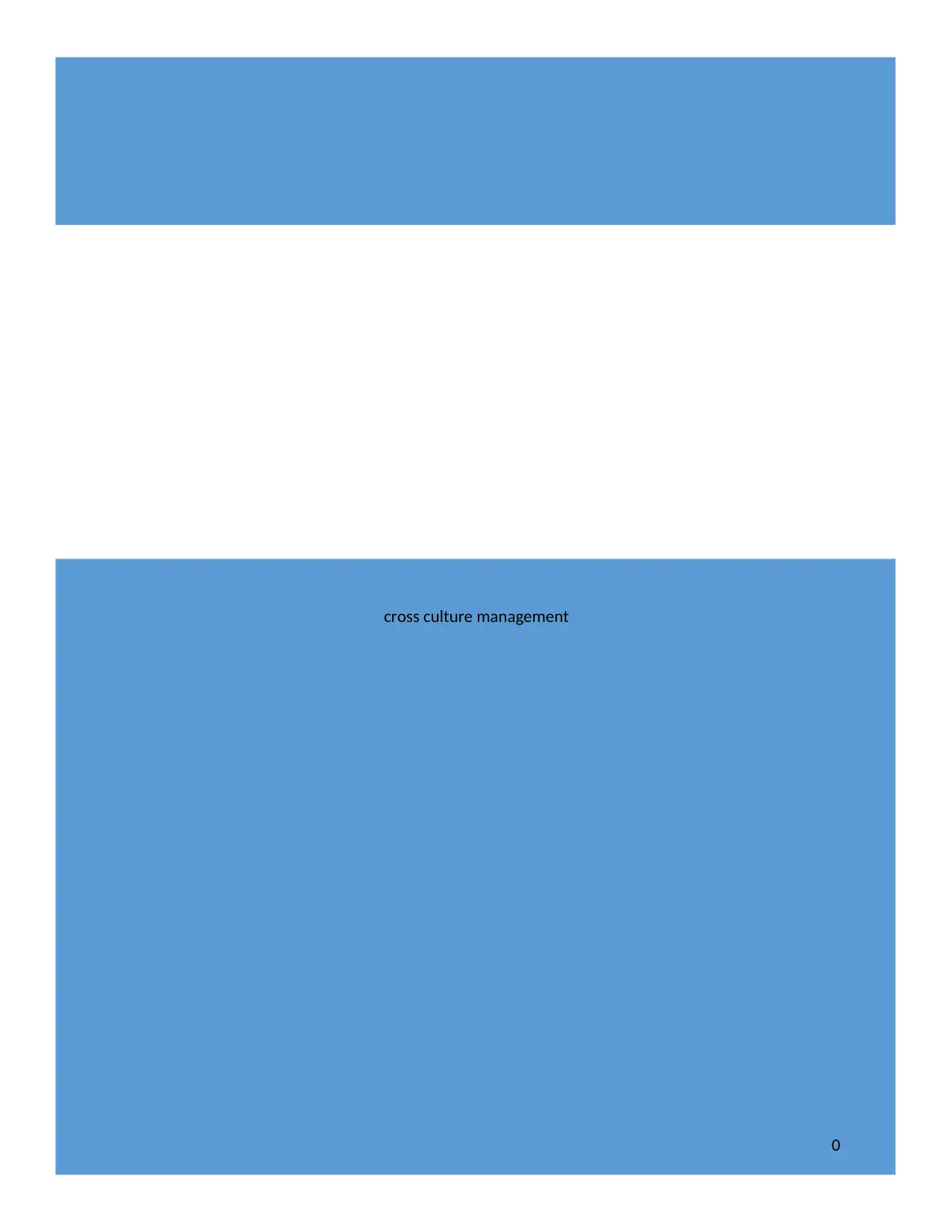
0
cross culture management
cross culture management
Paraphrase This Document
Need a fresh take? Get an instant paraphrase of this document with our AI Paraphraser
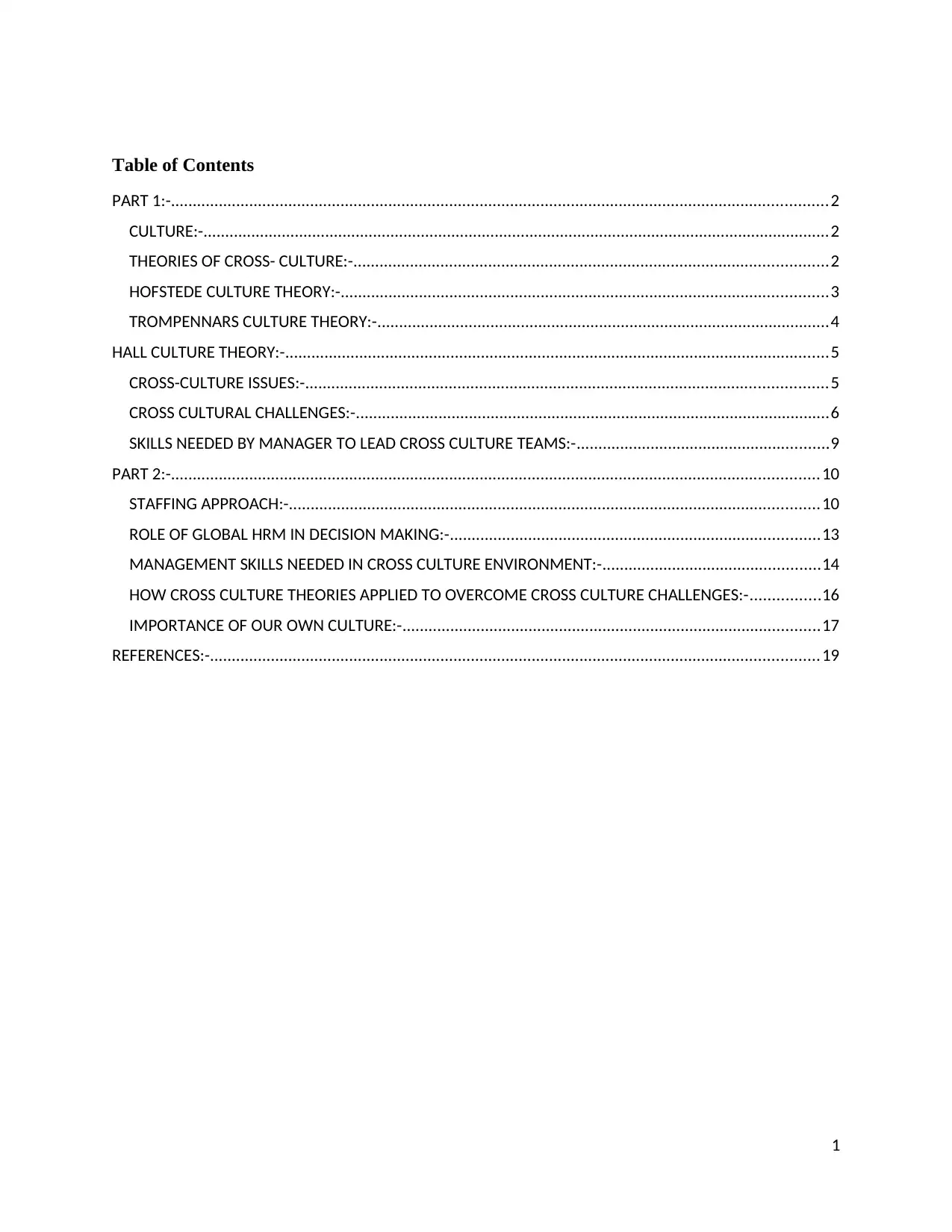
Table of Contents
PART 1:-.......................................................................................................................................................2
CULTURE:-................................................................................................................................................2
THEORIES OF CROSS- CULTURE:-.............................................................................................................2
HOFSTEDE CULTURE THEORY:-................................................................................................................3
TROMPENNARS CULTURE THEORY:-........................................................................................................4
HALL CULTURE THEORY:-.............................................................................................................................5
CROSS-CULTURE ISSUES:-........................................................................................................................5
CROSS CULTURAL CHALLENGES:-.............................................................................................................6
SKILLS NEEDED BY MANAGER TO LEAD CROSS CULTURE TEAMS:-..........................................................9
PART 2:-.....................................................................................................................................................10
STAFFING APPROACH:-..........................................................................................................................10
ROLE OF GLOBAL HRM IN DECISION MAKING:-.....................................................................................13
MANAGEMENT SKILLS NEEDED IN CROSS CULTURE ENVIRONMENT:-..................................................14
HOW CROSS CULTURE THEORIES APPLIED TO OVERCOME CROSS CULTURE CHALLENGES:-................16
IMPORTANCE OF OUR OWN CULTURE:-................................................................................................17
REFERENCES:-............................................................................................................................................19
1
PART 1:-.......................................................................................................................................................2
CULTURE:-................................................................................................................................................2
THEORIES OF CROSS- CULTURE:-.............................................................................................................2
HOFSTEDE CULTURE THEORY:-................................................................................................................3
TROMPENNARS CULTURE THEORY:-........................................................................................................4
HALL CULTURE THEORY:-.............................................................................................................................5
CROSS-CULTURE ISSUES:-........................................................................................................................5
CROSS CULTURAL CHALLENGES:-.............................................................................................................6
SKILLS NEEDED BY MANAGER TO LEAD CROSS CULTURE TEAMS:-..........................................................9
PART 2:-.....................................................................................................................................................10
STAFFING APPROACH:-..........................................................................................................................10
ROLE OF GLOBAL HRM IN DECISION MAKING:-.....................................................................................13
MANAGEMENT SKILLS NEEDED IN CROSS CULTURE ENVIRONMENT:-..................................................14
HOW CROSS CULTURE THEORIES APPLIED TO OVERCOME CROSS CULTURE CHALLENGES:-................16
IMPORTANCE OF OUR OWN CULTURE:-................................................................................................17
REFERENCES:-............................................................................................................................................19
1
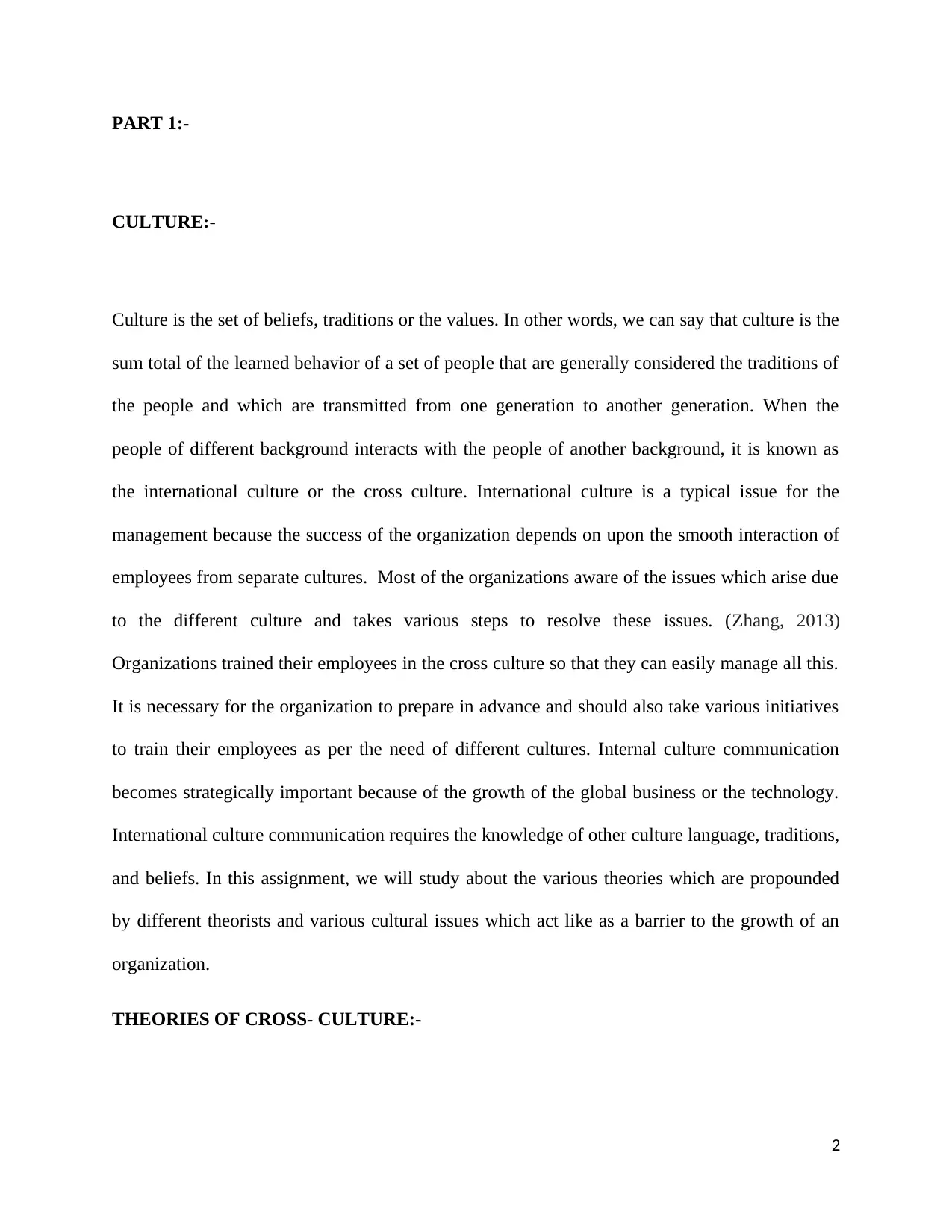
PART 1:-
CULTURE:-
Culture is the set of beliefs, traditions or the values. In other words, we can say that culture is the
sum total of the learned behavior of a set of people that are generally considered the traditions of
the people and which are transmitted from one generation to another generation. When the
people of different background interacts with the people of another background, it is known as
the international culture or the cross culture. International culture is a typical issue for the
management because the success of the organization depends on upon the smooth interaction of
employees from separate cultures. Most of the organizations aware of the issues which arise due
to the different culture and takes various steps to resolve these issues. (Zhang, 2013)
Organizations trained their employees in the cross culture so that they can easily manage all this.
It is necessary for the organization to prepare in advance and should also take various initiatives
to train their employees as per the need of different cultures. Internal culture communication
becomes strategically important because of the growth of the global business or the technology.
International culture communication requires the knowledge of other culture language, traditions,
and beliefs. In this assignment, we will study about the various theories which are propounded
by different theorists and various cultural issues which act like as a barrier to the growth of an
organization.
THEORIES OF CROSS- CULTURE:-
2
CULTURE:-
Culture is the set of beliefs, traditions or the values. In other words, we can say that culture is the
sum total of the learned behavior of a set of people that are generally considered the traditions of
the people and which are transmitted from one generation to another generation. When the
people of different background interacts with the people of another background, it is known as
the international culture or the cross culture. International culture is a typical issue for the
management because the success of the organization depends on upon the smooth interaction of
employees from separate cultures. Most of the organizations aware of the issues which arise due
to the different culture and takes various steps to resolve these issues. (Zhang, 2013)
Organizations trained their employees in the cross culture so that they can easily manage all this.
It is necessary for the organization to prepare in advance and should also take various initiatives
to train their employees as per the need of different cultures. Internal culture communication
becomes strategically important because of the growth of the global business or the technology.
International culture communication requires the knowledge of other culture language, traditions,
and beliefs. In this assignment, we will study about the various theories which are propounded
by different theorists and various cultural issues which act like as a barrier to the growth of an
organization.
THEORIES OF CROSS- CULTURE:-
2
⊘ This is a preview!⊘
Do you want full access?
Subscribe today to unlock all pages.

Trusted by 1+ million students worldwide
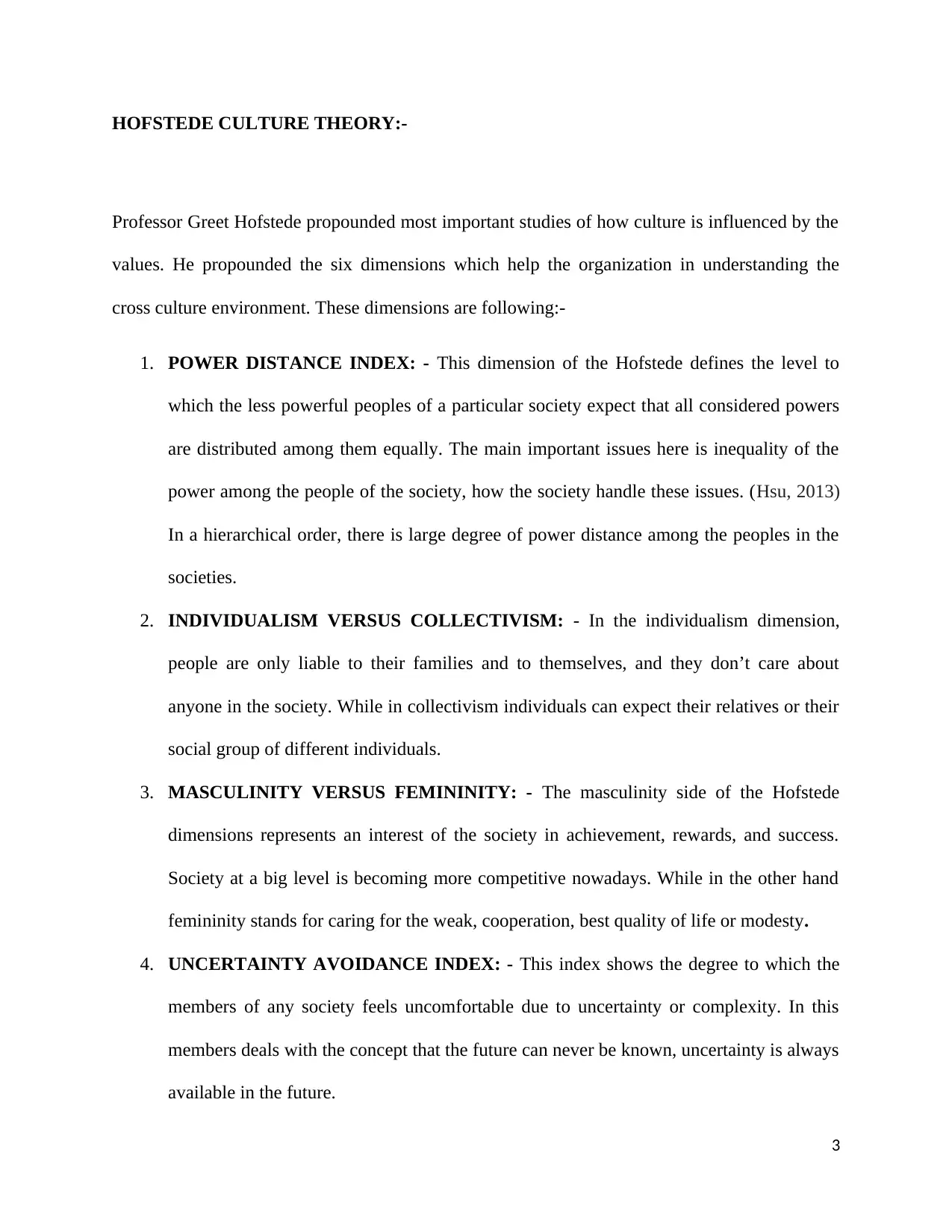
HOFSTEDE CULTURE THEORY:-
Professor Greet Hofstede propounded most important studies of how culture is influenced by the
values. He propounded the six dimensions which help the organization in understanding the
cross culture environment. These dimensions are following:-
1. POWER DISTANCE INDEX: - This dimension of the Hofstede defines the level to
which the less powerful peoples of a particular society expect that all considered powers
are distributed among them equally. The main important issues here is inequality of the
power among the people of the society, how the society handle these issues. (Hsu, 2013)
In a hierarchical order, there is large degree of power distance among the peoples in the
societies.
2. INDIVIDUALISM VERSUS COLLECTIVISM: - In the individualism dimension,
people are only liable to their families and to themselves, and they don’t care about
anyone in the society. While in collectivism individuals can expect their relatives or their
social group of different individuals.
3. MASCULINITY VERSUS FEMININITY: - The masculinity side of the Hofstede
dimensions represents an interest of the society in achievement, rewards, and success.
Society at a big level is becoming more competitive nowadays. While in the other hand
femininity stands for caring for the weak, cooperation, best quality of life or modesty.
4. UNCERTAINTY AVOIDANCE INDEX: - This index shows the degree to which the
members of any society feels uncomfortable due to uncertainty or complexity. In this
members deals with the concept that the future can never be known, uncertainty is always
available in the future.
3
Professor Greet Hofstede propounded most important studies of how culture is influenced by the
values. He propounded the six dimensions which help the organization in understanding the
cross culture environment. These dimensions are following:-
1. POWER DISTANCE INDEX: - This dimension of the Hofstede defines the level to
which the less powerful peoples of a particular society expect that all considered powers
are distributed among them equally. The main important issues here is inequality of the
power among the people of the society, how the society handle these issues. (Hsu, 2013)
In a hierarchical order, there is large degree of power distance among the peoples in the
societies.
2. INDIVIDUALISM VERSUS COLLECTIVISM: - In the individualism dimension,
people are only liable to their families and to themselves, and they don’t care about
anyone in the society. While in collectivism individuals can expect their relatives or their
social group of different individuals.
3. MASCULINITY VERSUS FEMININITY: - The masculinity side of the Hofstede
dimensions represents an interest of the society in achievement, rewards, and success.
Society at a big level is becoming more competitive nowadays. While in the other hand
femininity stands for caring for the weak, cooperation, best quality of life or modesty.
4. UNCERTAINTY AVOIDANCE INDEX: - This index shows the degree to which the
members of any society feels uncomfortable due to uncertainty or complexity. In this
members deals with the concept that the future can never be known, uncertainty is always
available in the future.
3
Paraphrase This Document
Need a fresh take? Get an instant paraphrase of this document with our AI Paraphraser
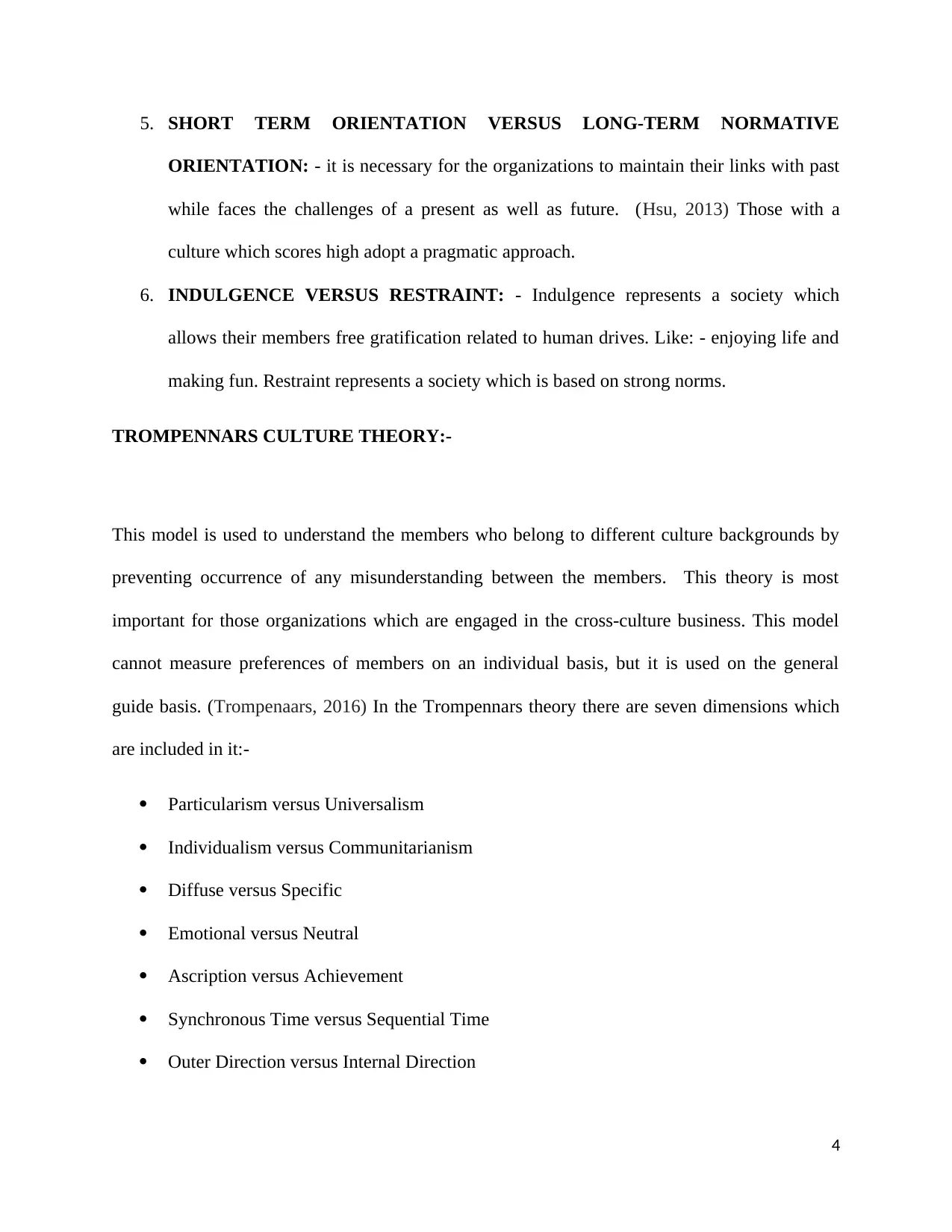
5. SHORT TERM ORIENTATION VERSUS LONG-TERM NORMATIVE
ORIENTATION: - it is necessary for the organizations to maintain their links with past
while faces the challenges of a present as well as future. (Hsu, 2013) Those with a
culture which scores high adopt a pragmatic approach.
6. INDULGENCE VERSUS RESTRAINT: - Indulgence represents a society which
allows their members free gratification related to human drives. Like: - enjoying life and
making fun. Restraint represents a society which is based on strong norms.
TROMPENNARS CULTURE THEORY:-
This model is used to understand the members who belong to different culture backgrounds by
preventing occurrence of any misunderstanding between the members. This theory is most
important for those organizations which are engaged in the cross-culture business. This model
cannot measure preferences of members on an individual basis, but it is used on the general
guide basis. (Trompenaars, 2016) In the Trompennars theory there are seven dimensions which
are included in it:-
Particularism versus Universalism
Individualism versus Communitarianism
Diffuse versus Specific
Emotional versus Neutral
Ascription versus Achievement
Synchronous Time versus Sequential Time
Outer Direction versus Internal Direction
4
ORIENTATION: - it is necessary for the organizations to maintain their links with past
while faces the challenges of a present as well as future. (Hsu, 2013) Those with a
culture which scores high adopt a pragmatic approach.
6. INDULGENCE VERSUS RESTRAINT: - Indulgence represents a society which
allows their members free gratification related to human drives. Like: - enjoying life and
making fun. Restraint represents a society which is based on strong norms.
TROMPENNARS CULTURE THEORY:-
This model is used to understand the members who belong to different culture backgrounds by
preventing occurrence of any misunderstanding between the members. This theory is most
important for those organizations which are engaged in the cross-culture business. This model
cannot measure preferences of members on an individual basis, but it is used on the general
guide basis. (Trompenaars, 2016) In the Trompennars theory there are seven dimensions which
are included in it:-
Particularism versus Universalism
Individualism versus Communitarianism
Diffuse versus Specific
Emotional versus Neutral
Ascription versus Achievement
Synchronous Time versus Sequential Time
Outer Direction versus Internal Direction
4
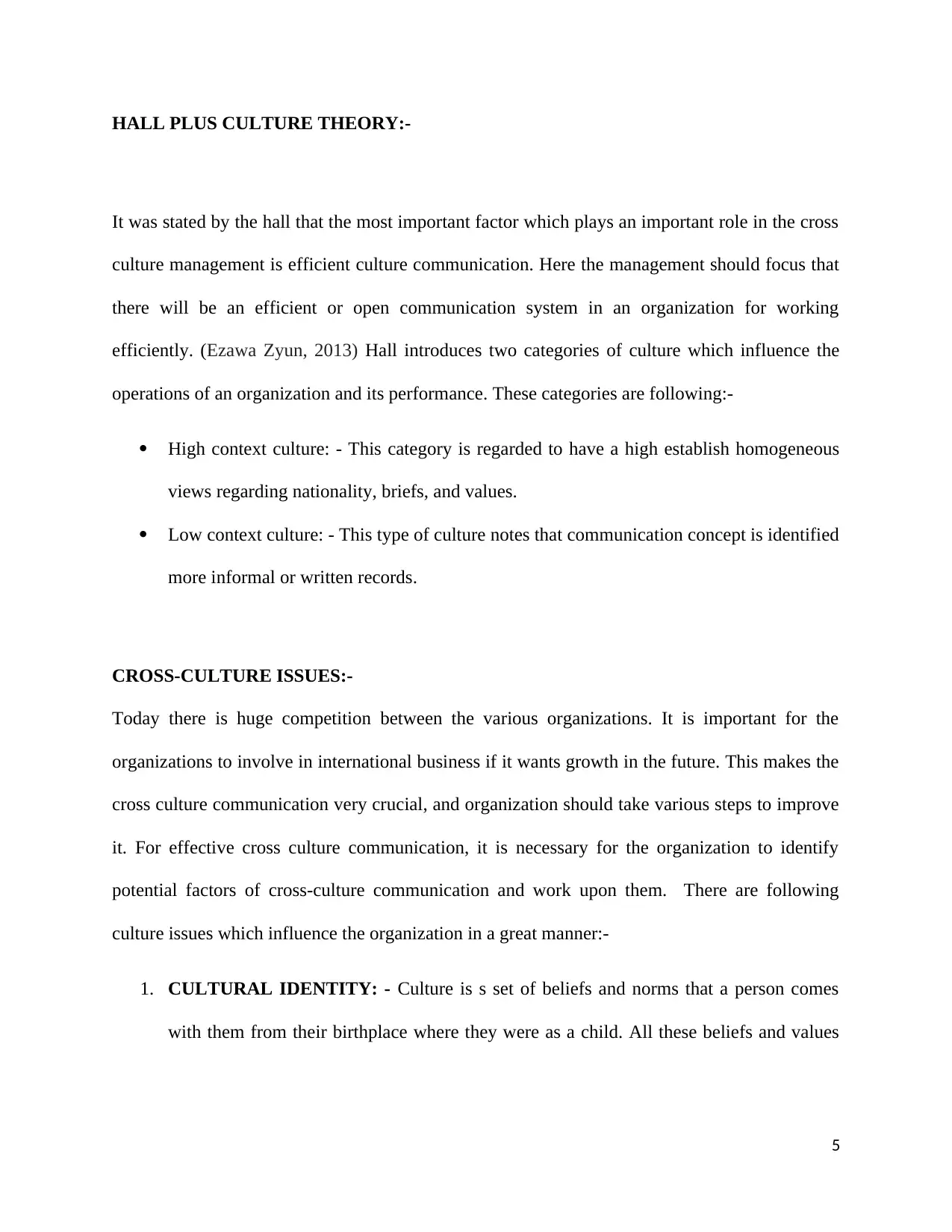
HALL PLUS CULTURE THEORY:-
It was stated by the hall that the most important factor which plays an important role in the cross
culture management is efficient culture communication. Here the management should focus that
there will be an efficient or open communication system in an organization for working
efficiently. (Ezawa Zyun, 2013) Hall introduces two categories of culture which influence the
operations of an organization and its performance. These categories are following:-
High context culture: - This category is regarded to have a high establish homogeneous
views regarding nationality, briefs, and values.
Low context culture: - This type of culture notes that communication concept is identified
more informal or written records.
CROSS-CULTURE ISSUES:-
Today there is huge competition between the various organizations. It is important for the
organizations to involve in international business if it wants growth in the future. This makes the
cross culture communication very crucial, and organization should take various steps to improve
it. For effective cross culture communication, it is necessary for the organization to identify
potential factors of cross-culture communication and work upon them. There are following
culture issues which influence the organization in a great manner:-
1. CULTURAL IDENTITY: - Culture is s set of beliefs and norms that a person comes
with them from their birthplace where they were as a child. All these beliefs and values
5
It was stated by the hall that the most important factor which plays an important role in the cross
culture management is efficient culture communication. Here the management should focus that
there will be an efficient or open communication system in an organization for working
efficiently. (Ezawa Zyun, 2013) Hall introduces two categories of culture which influence the
operations of an organization and its performance. These categories are following:-
High context culture: - This category is regarded to have a high establish homogeneous
views regarding nationality, briefs, and values.
Low context culture: - This type of culture notes that communication concept is identified
more informal or written records.
CROSS-CULTURE ISSUES:-
Today there is huge competition between the various organizations. It is important for the
organizations to involve in international business if it wants growth in the future. This makes the
cross culture communication very crucial, and organization should take various steps to improve
it. For effective cross culture communication, it is necessary for the organization to identify
potential factors of cross-culture communication and work upon them. There are following
culture issues which influence the organization in a great manner:-
1. CULTURAL IDENTITY: - Culture is s set of beliefs and norms that a person comes
with them from their birthplace where they were as a child. All these beliefs and values
5
⊘ This is a preview!⊘
Do you want full access?
Subscribe today to unlock all pages.

Trusted by 1+ million students worldwide
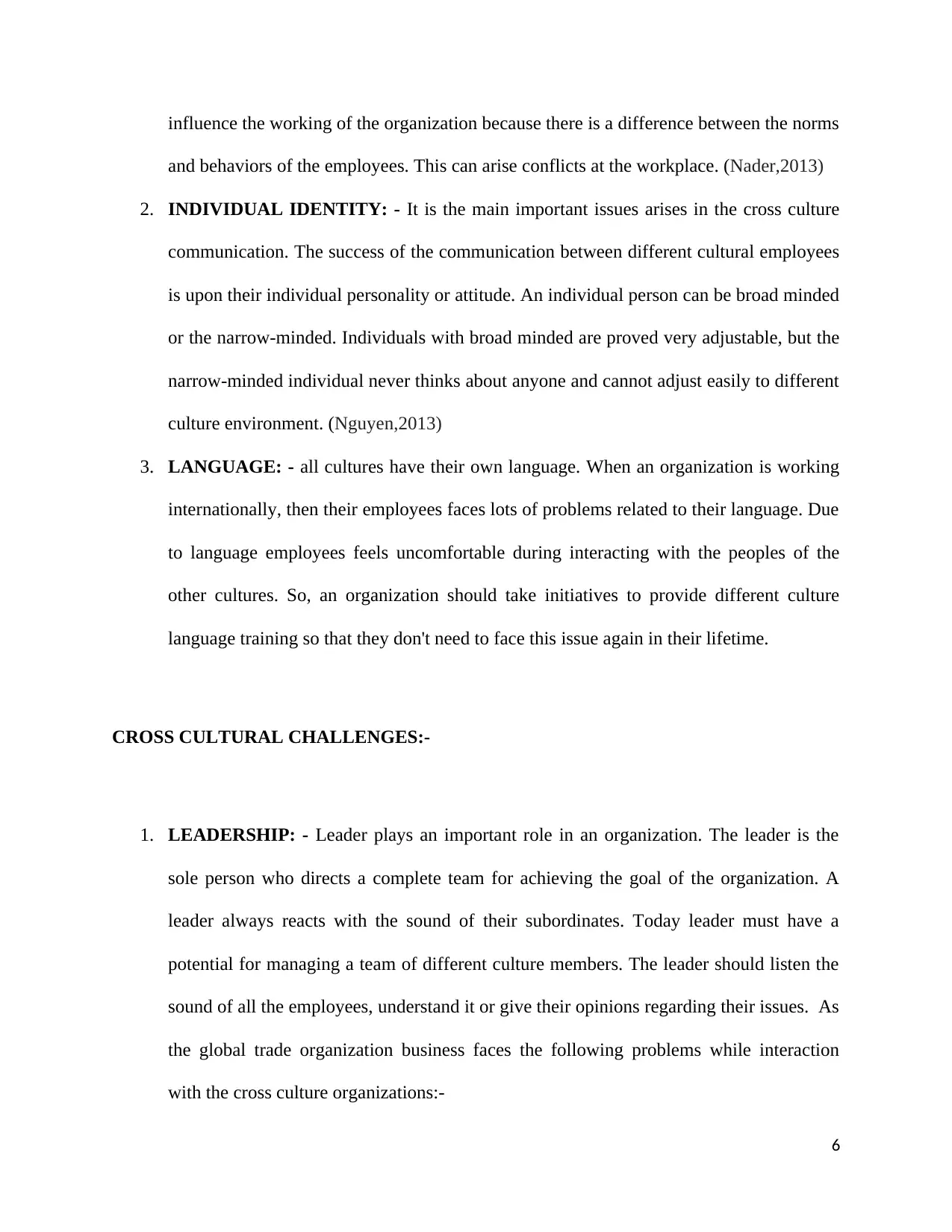
influence the working of the organization because there is a difference between the norms
and behaviors of the employees. This can arise conflicts at the workplace. (Nader,2013)
2. INDIVIDUAL IDENTITY: - It is the main important issues arises in the cross culture
communication. The success of the communication between different cultural employees
is upon their individual personality or attitude. An individual person can be broad minded
or the narrow-minded. Individuals with broad minded are proved very adjustable, but the
narrow-minded individual never thinks about anyone and cannot adjust easily to different
culture environment. (Nguyen,2013)
3. LANGUAGE: - all cultures have their own language. When an organization is working
internationally, then their employees faces lots of problems related to their language. Due
to language employees feels uncomfortable during interacting with the peoples of the
other cultures. So, an organization should take initiatives to provide different culture
language training so that they don't need to face this issue again in their lifetime.
CROSS CULTURAL CHALLENGES:-
1. LEADERSHIP: - Leader plays an important role in an organization. The leader is the
sole person who directs a complete team for achieving the goal of the organization. A
leader always reacts with the sound of their subordinates. Today leader must have a
potential for managing a team of different culture members. The leader should listen the
sound of all the employees, understand it or give their opinions regarding their issues. As
the global trade organization business faces the following problems while interaction
with the cross culture organizations:-
6
and behaviors of the employees. This can arise conflicts at the workplace. (Nader,2013)
2. INDIVIDUAL IDENTITY: - It is the main important issues arises in the cross culture
communication. The success of the communication between different cultural employees
is upon their individual personality or attitude. An individual person can be broad minded
or the narrow-minded. Individuals with broad minded are proved very adjustable, but the
narrow-minded individual never thinks about anyone and cannot adjust easily to different
culture environment. (Nguyen,2013)
3. LANGUAGE: - all cultures have their own language. When an organization is working
internationally, then their employees faces lots of problems related to their language. Due
to language employees feels uncomfortable during interacting with the peoples of the
other cultures. So, an organization should take initiatives to provide different culture
language training so that they don't need to face this issue again in their lifetime.
CROSS CULTURAL CHALLENGES:-
1. LEADERSHIP: - Leader plays an important role in an organization. The leader is the
sole person who directs a complete team for achieving the goal of the organization. A
leader always reacts with the sound of their subordinates. Today leader must have a
potential for managing a team of different culture members. The leader should listen the
sound of all the employees, understand it or give their opinions regarding their issues. As
the global trade organization business faces the following problems while interaction
with the cross culture organizations:-
6
Paraphrase This Document
Need a fresh take? Get an instant paraphrase of this document with our AI Paraphraser
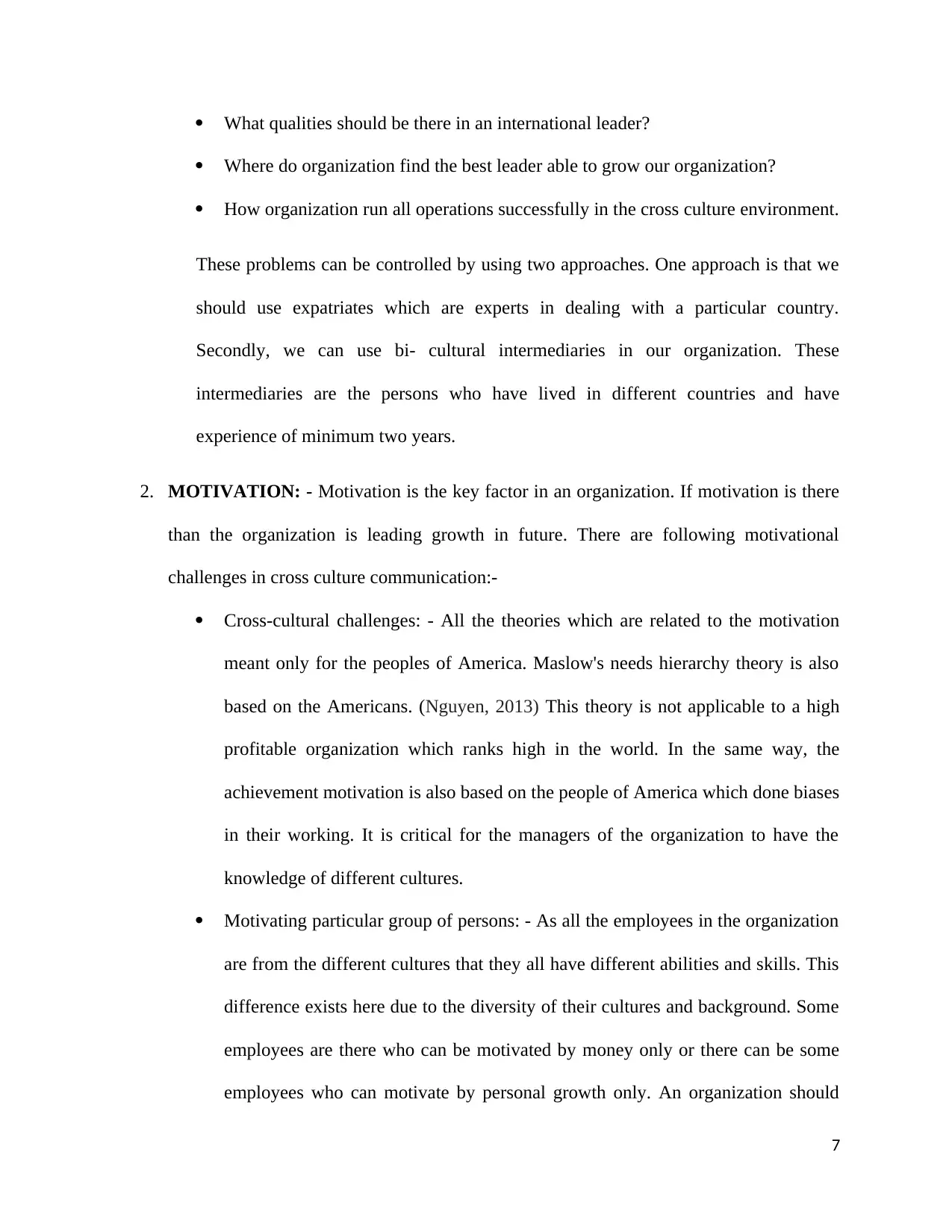
What qualities should be there in an international leader?
Where do organization find the best leader able to grow our organization?
How organization run all operations successfully in the cross culture environment.
These problems can be controlled by using two approaches. One approach is that we
should use expatriates which are experts in dealing with a particular country.
Secondly, we can use bi- cultural intermediaries in our organization. These
intermediaries are the persons who have lived in different countries and have
experience of minimum two years.
2. MOTIVATION: - Motivation is the key factor in an organization. If motivation is there
than the organization is leading growth in future. There are following motivational
challenges in cross culture communication:-
Cross-cultural challenges: - All the theories which are related to the motivation
meant only for the peoples of America. Maslow's needs hierarchy theory is also
based on the Americans. (Nguyen, 2013) This theory is not applicable to a high
profitable organization which ranks high in the world. In the same way, the
achievement motivation is also based on the people of America which done biases
in their working. It is critical for the managers of the organization to have the
knowledge of different cultures.
Motivating particular group of persons: - As all the employees in the organization
are from the different cultures that they all have different abilities and skills. This
difference exists here due to the diversity of their cultures and background. Some
employees are there who can be motivated by money only or there can be some
employees who can motivate by personal growth only. An organization should
7
Where do organization find the best leader able to grow our organization?
How organization run all operations successfully in the cross culture environment.
These problems can be controlled by using two approaches. One approach is that we
should use expatriates which are experts in dealing with a particular country.
Secondly, we can use bi- cultural intermediaries in our organization. These
intermediaries are the persons who have lived in different countries and have
experience of minimum two years.
2. MOTIVATION: - Motivation is the key factor in an organization. If motivation is there
than the organization is leading growth in future. There are following motivational
challenges in cross culture communication:-
Cross-cultural challenges: - All the theories which are related to the motivation
meant only for the peoples of America. Maslow's needs hierarchy theory is also
based on the Americans. (Nguyen, 2013) This theory is not applicable to a high
profitable organization which ranks high in the world. In the same way, the
achievement motivation is also based on the people of America which done biases
in their working. It is critical for the managers of the organization to have the
knowledge of different cultures.
Motivating particular group of persons: - As all the employees in the organization
are from the different cultures that they all have different abilities and skills. This
difference exists here due to the diversity of their cultures and background. Some
employees are there who can be motivated by money only or there can be some
employees who can motivate by personal growth only. An organization should
7
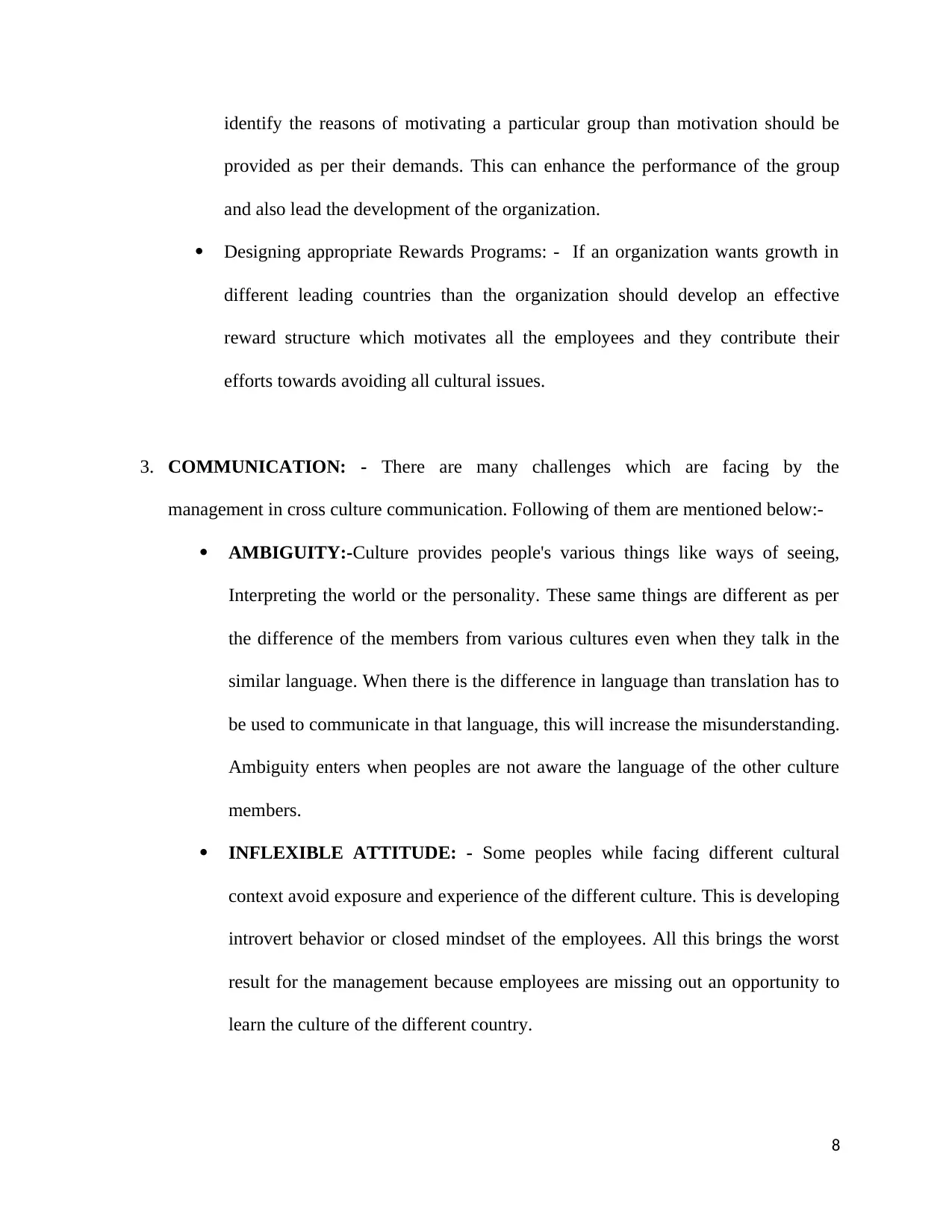
identify the reasons of motivating a particular group than motivation should be
provided as per their demands. This can enhance the performance of the group
and also lead the development of the organization.
Designing appropriate Rewards Programs: - If an organization wants growth in
different leading countries than the organization should develop an effective
reward structure which motivates all the employees and they contribute their
efforts towards avoiding all cultural issues.
3. COMMUNICATION: - There are many challenges which are facing by the
management in cross culture communication. Following of them are mentioned below:-
AMBIGUITY:-Culture provides people's various things like ways of seeing,
Interpreting the world or the personality. These same things are different as per
the difference of the members from various cultures even when they talk in the
similar language. When there is the difference in language than translation has to
be used to communicate in that language, this will increase the misunderstanding.
Ambiguity enters when peoples are not aware the language of the other culture
members.
INFLEXIBLE ATTITUDE: - Some peoples while facing different cultural
context avoid exposure and experience of the different culture. This is developing
introvert behavior or closed mindset of the employees. All this brings the worst
result for the management because employees are missing out an opportunity to
learn the culture of the different country.
8
provided as per their demands. This can enhance the performance of the group
and also lead the development of the organization.
Designing appropriate Rewards Programs: - If an organization wants growth in
different leading countries than the organization should develop an effective
reward structure which motivates all the employees and they contribute their
efforts towards avoiding all cultural issues.
3. COMMUNICATION: - There are many challenges which are facing by the
management in cross culture communication. Following of them are mentioned below:-
AMBIGUITY:-Culture provides people's various things like ways of seeing,
Interpreting the world or the personality. These same things are different as per
the difference of the members from various cultures even when they talk in the
similar language. When there is the difference in language than translation has to
be used to communicate in that language, this will increase the misunderstanding.
Ambiguity enters when peoples are not aware the language of the other culture
members.
INFLEXIBLE ATTITUDE: - Some peoples while facing different cultural
context avoid exposure and experience of the different culture. This is developing
introvert behavior or closed mindset of the employees. All this brings the worst
result for the management because employees are missing out an opportunity to
learn the culture of the different country.
8
⊘ This is a preview!⊘
Do you want full access?
Subscribe today to unlock all pages.

Trusted by 1+ million students worldwide
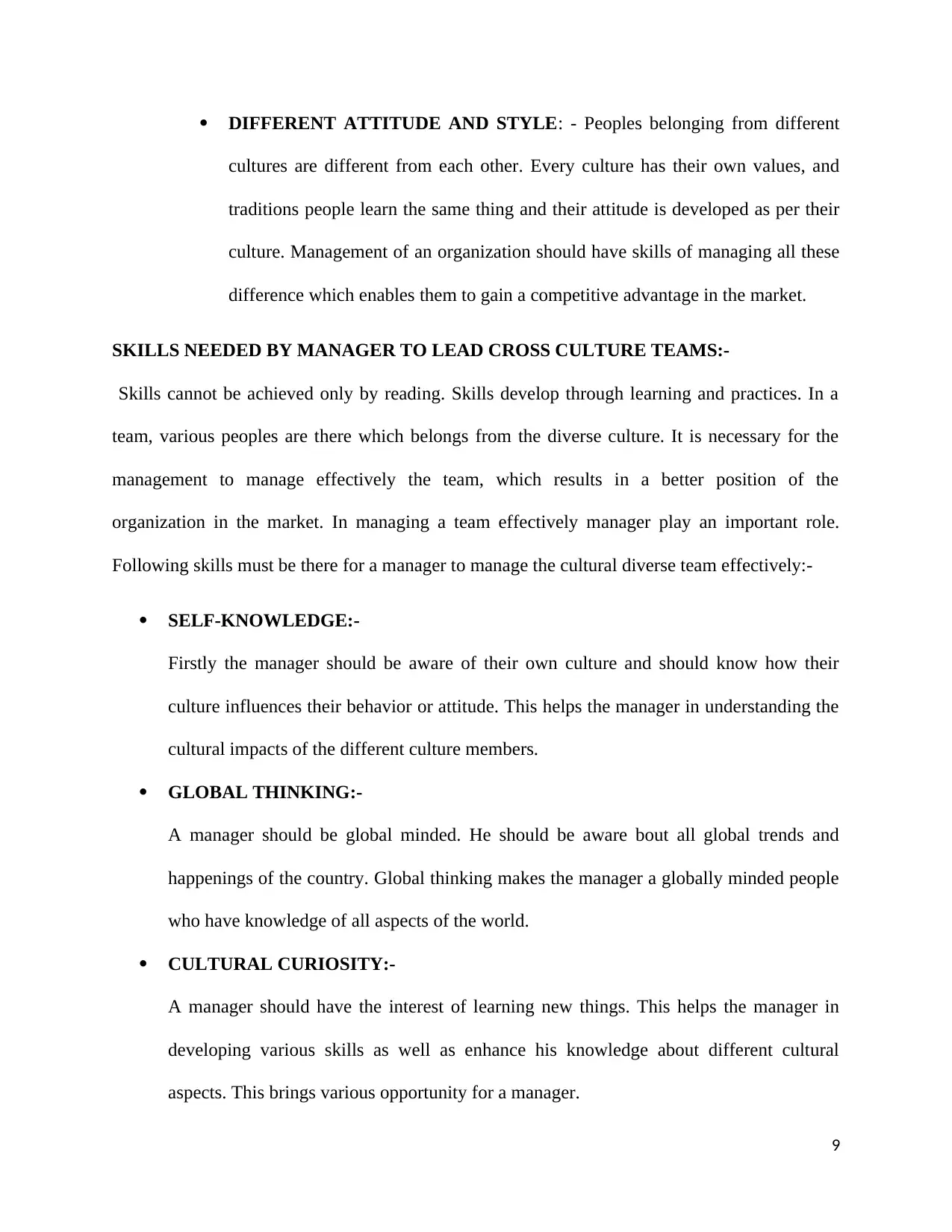
DIFFERENT ATTITUDE AND STYLE: - Peoples belonging from different
cultures are different from each other. Every culture has their own values, and
traditions people learn the same thing and their attitude is developed as per their
culture. Management of an organization should have skills of managing all these
difference which enables them to gain a competitive advantage in the market.
SKILLS NEEDED BY MANAGER TO LEAD CROSS CULTURE TEAMS:-
Skills cannot be achieved only by reading. Skills develop through learning and practices. In a
team, various peoples are there which belongs from the diverse culture. It is necessary for the
management to manage effectively the team, which results in a better position of the
organization in the market. In managing a team effectively manager play an important role.
Following skills must be there for a manager to manage the cultural diverse team effectively:-
SELF-KNOWLEDGE:-
Firstly the manager should be aware of their own culture and should know how their
culture influences their behavior or attitude. This helps the manager in understanding the
cultural impacts of the different culture members.
GLOBAL THINKING:-
A manager should be global minded. He should be aware bout all global trends and
happenings of the country. Global thinking makes the manager a globally minded people
who have knowledge of all aspects of the world.
CULTURAL CURIOSITY:-
A manager should have the interest of learning new things. This helps the manager in
developing various skills as well as enhance his knowledge about different cultural
aspects. This brings various opportunity for a manager.
9
cultures are different from each other. Every culture has their own values, and
traditions people learn the same thing and their attitude is developed as per their
culture. Management of an organization should have skills of managing all these
difference which enables them to gain a competitive advantage in the market.
SKILLS NEEDED BY MANAGER TO LEAD CROSS CULTURE TEAMS:-
Skills cannot be achieved only by reading. Skills develop through learning and practices. In a
team, various peoples are there which belongs from the diverse culture. It is necessary for the
management to manage effectively the team, which results in a better position of the
organization in the market. In managing a team effectively manager play an important role.
Following skills must be there for a manager to manage the cultural diverse team effectively:-
SELF-KNOWLEDGE:-
Firstly the manager should be aware of their own culture and should know how their
culture influences their behavior or attitude. This helps the manager in understanding the
cultural impacts of the different culture members.
GLOBAL THINKING:-
A manager should be global minded. He should be aware bout all global trends and
happenings of the country. Global thinking makes the manager a globally minded people
who have knowledge of all aspects of the world.
CULTURAL CURIOSITY:-
A manager should have the interest of learning new things. This helps the manager in
developing various skills as well as enhance his knowledge about different cultural
aspects. This brings various opportunity for a manager.
9
Paraphrase This Document
Need a fresh take? Get an instant paraphrase of this document with our AI Paraphraser
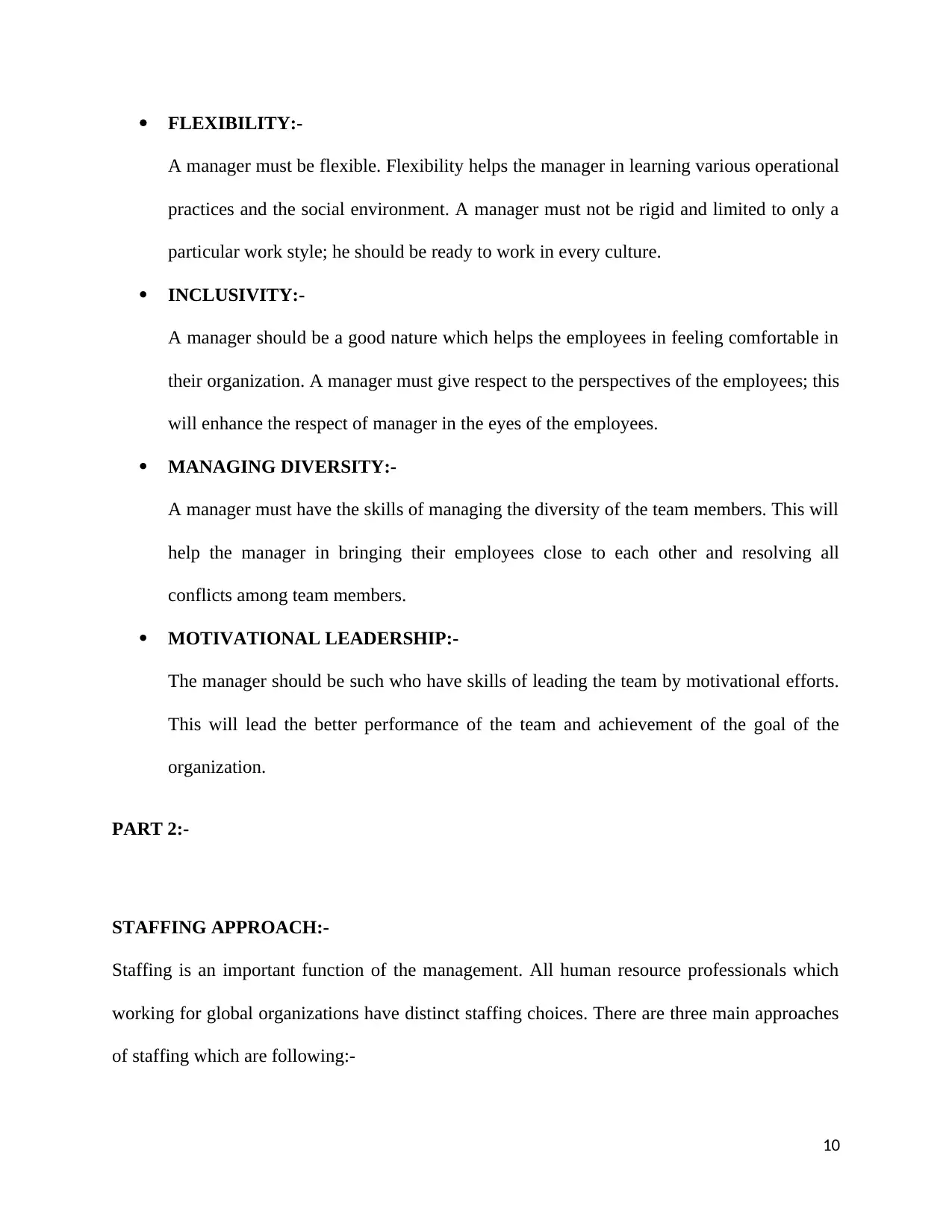
FLEXIBILITY:-
A manager must be flexible. Flexibility helps the manager in learning various operational
practices and the social environment. A manager must not be rigid and limited to only a
particular work style; he should be ready to work in every culture.
INCLUSIVITY:-
A manager should be a good nature which helps the employees in feeling comfortable in
their organization. A manager must give respect to the perspectives of the employees; this
will enhance the respect of manager in the eyes of the employees.
MANAGING DIVERSITY:-
A manager must have the skills of managing the diversity of the team members. This will
help the manager in bringing their employees close to each other and resolving all
conflicts among team members.
MOTIVATIONAL LEADERSHIP:-
The manager should be such who have skills of leading the team by motivational efforts.
This will lead the better performance of the team and achievement of the goal of the
organization.
PART 2:-
STAFFING APPROACH:-
Staffing is an important function of the management. All human resource professionals which
working for global organizations have distinct staffing choices. There are three main approaches
of staffing which are following:-
10
A manager must be flexible. Flexibility helps the manager in learning various operational
practices and the social environment. A manager must not be rigid and limited to only a
particular work style; he should be ready to work in every culture.
INCLUSIVITY:-
A manager should be a good nature which helps the employees in feeling comfortable in
their organization. A manager must give respect to the perspectives of the employees; this
will enhance the respect of manager in the eyes of the employees.
MANAGING DIVERSITY:-
A manager must have the skills of managing the diversity of the team members. This will
help the manager in bringing their employees close to each other and resolving all
conflicts among team members.
MOTIVATIONAL LEADERSHIP:-
The manager should be such who have skills of leading the team by motivational efforts.
This will lead the better performance of the team and achievement of the goal of the
organization.
PART 2:-
STAFFING APPROACH:-
Staffing is an important function of the management. All human resource professionals which
working for global organizations have distinct staffing choices. There are three main approaches
of staffing which are following:-
10
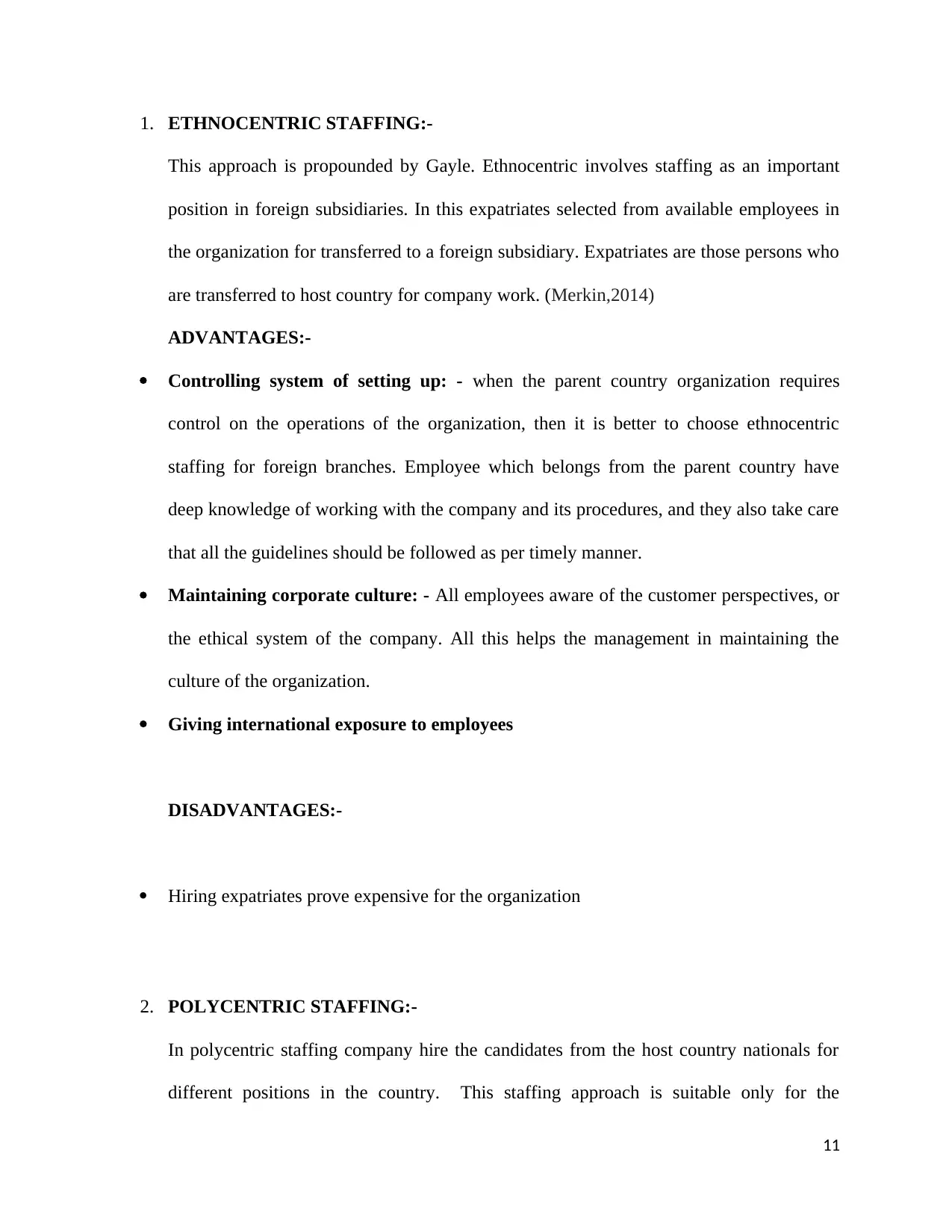
1. ETHNOCENTRIC STAFFING:-
This approach is propounded by Gayle. Ethnocentric involves staffing as an important
position in foreign subsidiaries. In this expatriates selected from available employees in
the organization for transferred to a foreign subsidiary. Expatriates are those persons who
are transferred to host country for company work. (Merkin,2014)
ADVANTAGES:-
Controlling system of setting up: - when the parent country organization requires
control on the operations of the organization, then it is better to choose ethnocentric
staffing for foreign branches. Employee which belongs from the parent country have
deep knowledge of working with the company and its procedures, and they also take care
that all the guidelines should be followed as per timely manner.
Maintaining corporate culture: - All employees aware of the customer perspectives, or
the ethical system of the company. All this helps the management in maintaining the
culture of the organization.
Giving international exposure to employees
DISADVANTAGES:-
Hiring expatriates prove expensive for the organization
2. POLYCENTRIC STAFFING:-
In polycentric staffing company hire the candidates from the host country nationals for
different positions in the country. This staffing approach is suitable only for the
11
This approach is propounded by Gayle. Ethnocentric involves staffing as an important
position in foreign subsidiaries. In this expatriates selected from available employees in
the organization for transferred to a foreign subsidiary. Expatriates are those persons who
are transferred to host country for company work. (Merkin,2014)
ADVANTAGES:-
Controlling system of setting up: - when the parent country organization requires
control on the operations of the organization, then it is better to choose ethnocentric
staffing for foreign branches. Employee which belongs from the parent country have
deep knowledge of working with the company and its procedures, and they also take care
that all the guidelines should be followed as per timely manner.
Maintaining corporate culture: - All employees aware of the customer perspectives, or
the ethical system of the company. All this helps the management in maintaining the
culture of the organization.
Giving international exposure to employees
DISADVANTAGES:-
Hiring expatriates prove expensive for the organization
2. POLYCENTRIC STAFFING:-
In polycentric staffing company hire the candidates from the host country nationals for
different positions in the country. This staffing approach is suitable only for the
11
⊘ This is a preview!⊘
Do you want full access?
Subscribe today to unlock all pages.

Trusted by 1+ million students worldwide
1 out of 22
Related Documents
Your All-in-One AI-Powered Toolkit for Academic Success.
+13062052269
info@desklib.com
Available 24*7 on WhatsApp / Email
![[object Object]](/_next/static/media/star-bottom.7253800d.svg)
Unlock your academic potential
Copyright © 2020–2025 A2Z Services. All Rights Reserved. Developed and managed by ZUCOL.





